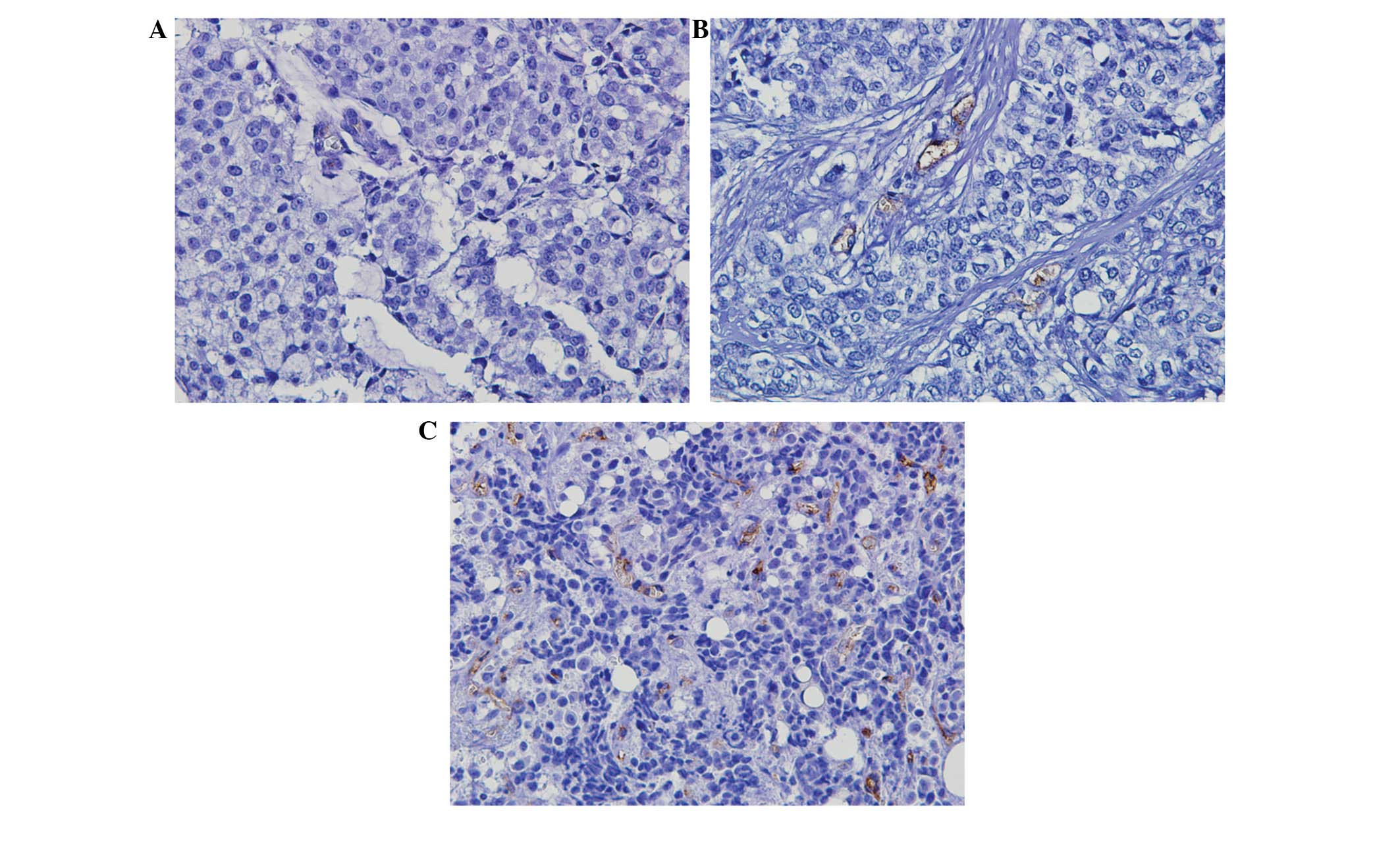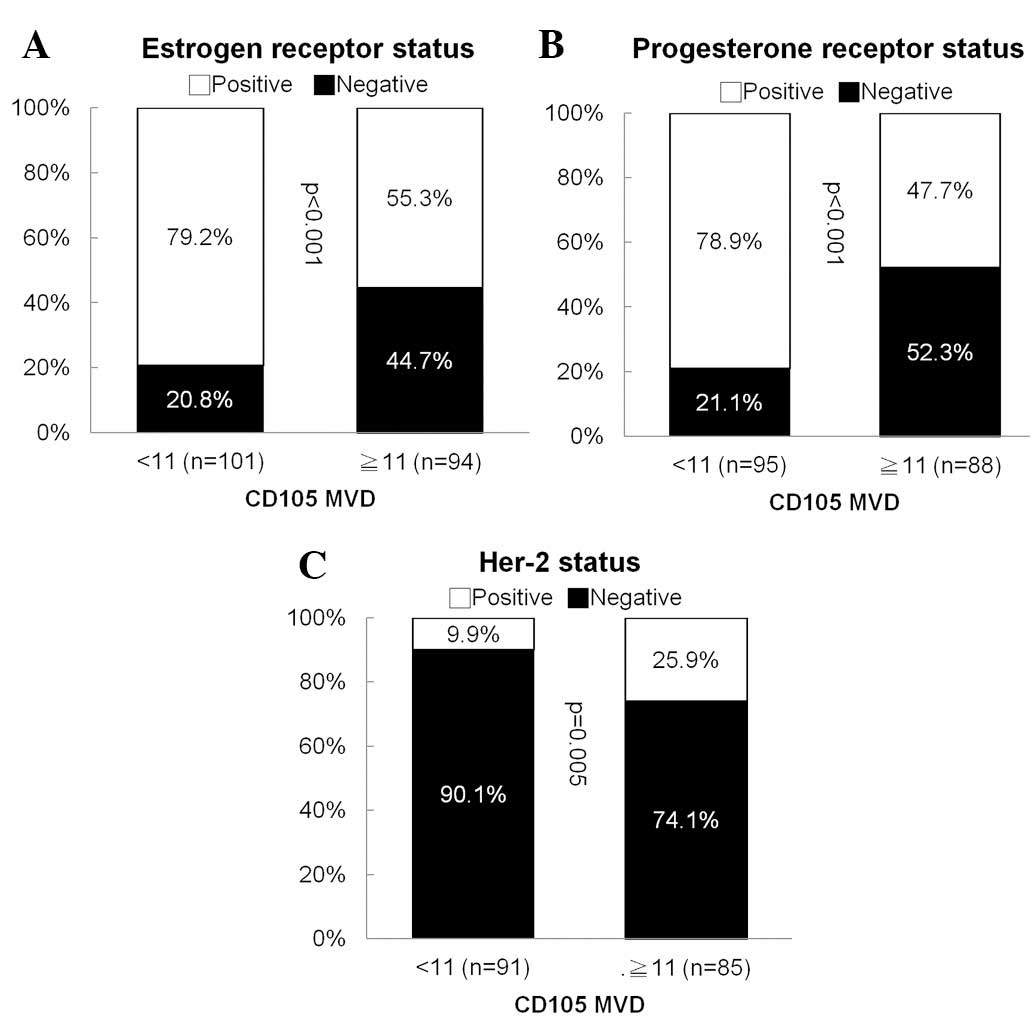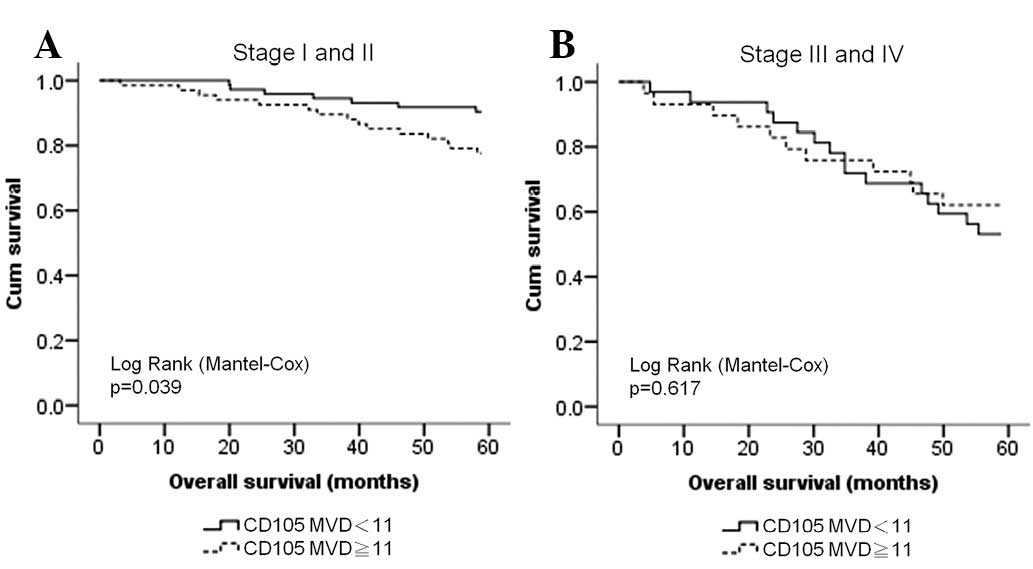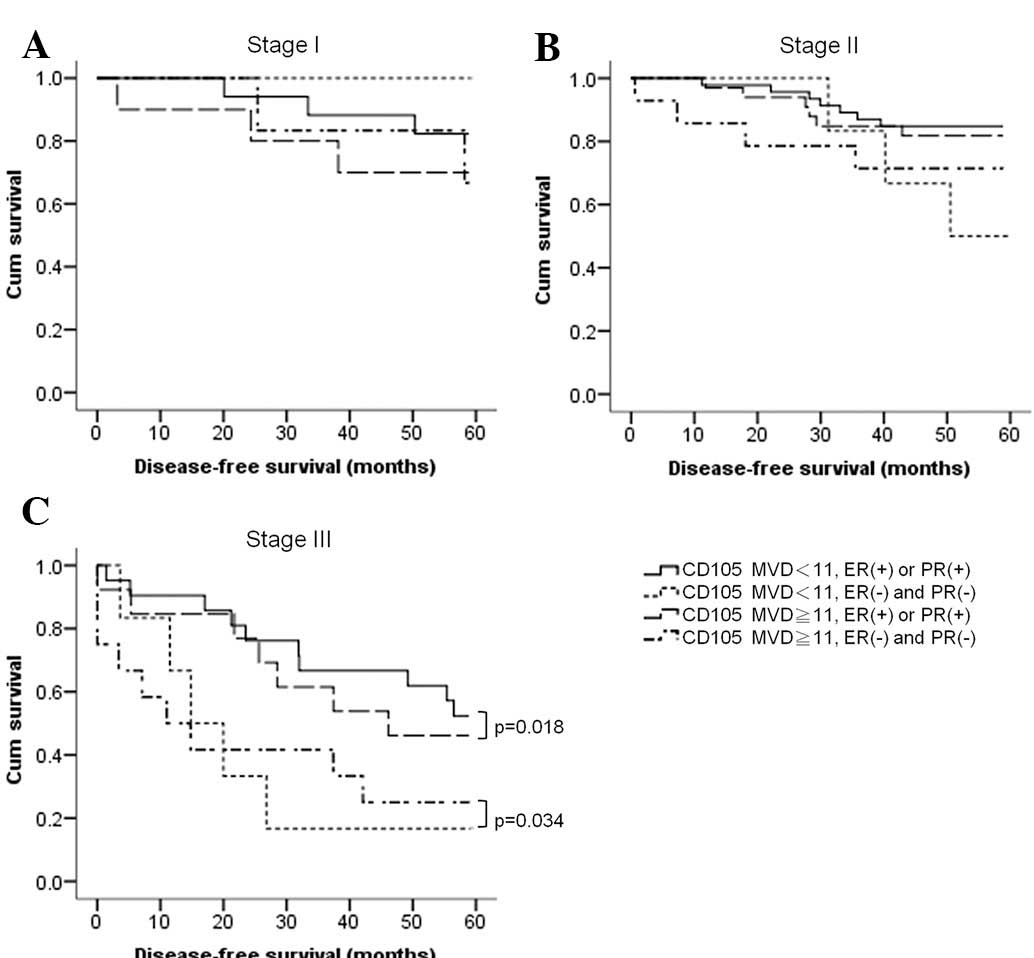|
1.
|
Jemal A, Siegel R, Xu J and Ward E: Cancer
statistics, 2010. CA Cancer J Clin. 60:277–300. 2010. View Article : Google Scholar
|
|
2.
|
Cianfrocca M and Gradishar W: New
molecular classifications of breast cancer. CA Cancer J Clin.
59:303–313. 2009. View Article : Google Scholar
|
|
3.
|
Folkman J, Watson K, Ingber D and Hanahan
D: Induction of angiogenesis during the transition from hyperplasia
to neoplasia. Nature. 339:58–61. 1989. View
Article : Google Scholar : PubMed/NCBI
|
|
4.
|
Gasparini G: Clinical significance of the
determination of angiogenesis in human breast cancer: update of the
biological background and overview of the Vicenza studies. Eur J
Cancer. 32A:2485–2493. 1996. View Article : Google Scholar : PubMed/NCBI
|
|
5.
|
Uzzan B, Nicolas P, Cucherat M and Perret
GY: Microvessel density as a prognostic factor in women with breast
cancer: a systematic review of the literature and meta-analysis.
Cancer Res. 64:2941–2955. 2004. View Article : Google Scholar : PubMed/NCBI
|
|
6.
|
Nico B, Benagiano V, Mangieri D, Maruotti
N, Vacca A and Ribatti D: Evaluation of microvascular density in
tumors: pro and contra. Histol Histopathol. 23:601–607.
2008.PubMed/NCBI
|
|
7.
|
Fox SB, Gasparini G and Harris AL:
Angiogenesis: pathological, prognostic, and growth-factor pathways
and their link to trial design and anticancer drugs. Lancet Oncol.
2:278–289. 2001. View Article : Google Scholar : PubMed/NCBI
|
|
8.
|
Woodfin A, Voisin MB and Nourshargh S:
PECAM-1: a multi-functional molecule in inflammation and vascular
biology. Arterioscler Thromb Vasc Biol. 27:2514–2523. 2007.
View Article : Google Scholar : PubMed/NCBI
|
|
9.
|
Mineo TC, Ambrogi V, Baldi A, et al:
Prognostic impact of VEGF, CD31, CD34, and CD105 expression and
tumour vessel invasion after radical surgery for IB-IIA non-small
cell lung cancer. J Clin Pathol. 57:591–597. 2004. View Article : Google Scholar : PubMed/NCBI
|
|
10.
|
da Silva BB, Lopes-Costa PV, dos Santos
AR, et al: Comparison of three vascular endothelial markers in the
evaluation of microvessel density in breast cancer. Eur J Gynaecol
Oncol. 30:285–288. 2009.PubMed/NCBI
|
|
11.
|
Tanaka F, Otake Y, Yanagihara K, et al:
Evaluation of angio-genesis in non-small cell lung cancer:
comparison between anti-CD34 antibody and anti-CD105 antibody. Clin
Cancer Res. 7:3410–3415. 2001.PubMed/NCBI
|
|
12.
|
Fonsatti E, Del Vecchio L, Altomonte M, et
al: Endoglin: an accessory component of the TGF-beta-binding
receptor-complex with diagnostic, prognostic, and
bioimmunotherapeutic potential in human malignancies. J Cell
Physiol. 188:1–7. 2001. View
Article : Google Scholar : PubMed/NCBI
|
|
13.
|
Kumar S, Ghellal A, Li C, et al: Breast
carcinoma: vascular density determined using CD105 antibody
correlates with tumor prognosis. Cancer Res. 59:856–861.
1999.PubMed/NCBI
|
|
14.
|
Dallas NA, Samuel S, Xia L, et al:
Endoglin (CD105): a marker of tumor vasculature and potential
target for therapy. Clin Cancer Res. 14:1931–1937. 2008. View Article : Google Scholar : PubMed/NCBI
|
|
15.
|
Yao Y, Kubota T, Takeuchi H and Sato K:
Prognostic significance of microvessel density determined by an
anti-CD105/endoglin monoclonal antibody in astrocytic tumors:
comparison with an anti-CD31 monoclonal antibody. Neuropathology.
25:201–206. 2005. View Article : Google Scholar : PubMed/NCBI
|
|
16.
|
Elliott RL and Blobe GC: Role of
transforming growth factor beta in human cancer. J Clin Oncol.
23:2078–2093. 2005. View Article : Google Scholar : PubMed/NCBI
|
|
17.
|
Yamamoto T, Kozawa O, Tanabe K, et al:
Involvement of p38 MAP kinase in TGF-beta-stimulated VEGF synthesis
in aortic smooth muscle cells. J Cell Biochem. 82:591–598. 2001.
View Article : Google Scholar : PubMed/NCBI
|
|
18.
|
Li C, Hampson IN, Hampson L, Kumar P,
Bernabeu C and Kumar S: CD105 antagonizes the inhibitory signaling
of transforming growth factor beta1 on human vascular endothelial
cells. FASEB J. 14:55–64. 2000.PubMed/NCBI
|
|
19.
|
Seon BK, Haba A, Matsuno F, et al:
Endoglin-targeted cancer therapy. Curr Drug Deliv. 8:135–143. 2011.
View Article : Google Scholar : PubMed/NCBI
|
|
20.
|
Marinho A, Soares R, Ferro J, Lacerda M
and Schmitt FC: Angiogenesis in breast cancer is related to age but
not to other prognostic parameters. Pathol Res Pract. 193:267–273.
1997. View Article : Google Scholar : PubMed/NCBI
|
|
21.
|
Sørlie T, Perou CM, Tibshirani R, et al:
Gene expression patterns of breast carcinomas distinguish tumor
subclasses with clinical implications. Proc Natl Acad Sci USA.
98:10869–10874. 2001.PubMed/NCBI
|
|
22.
|
Liedtke C and Kiesel L: Current issues of
targeted therapy in metastatic triple-negative breast cancer.
Breast Care (Basel). 6:234–239. 2011. View Article : Google Scholar : PubMed/NCBI
|
|
23.
|
Niers TM, Richel DJ, Meijers JC and
Schlingemann RO: Vascular endothelial growth factor in the
circulation in cancer patients may not be a relevant biomarker.
PLoS One. 6:e198732011. View Article : Google Scholar : PubMed/NCBI
|
|
24.
|
Pang R and Poon RT: Angiogenesis and
antiangiogenic therapy in hepatocellular carcinoma. Cancer Lett.
242:151–167. 2006. View Article : Google Scholar : PubMed/NCBI
|
|
25.
|
Webber K, Cooper A, Kleiven H, Yip D and
Goldstein D: Management of metastatic renal cell carcinoma in the
era of targeted therapies. Intern Med J. 41:594–605. 2011.
View Article : Google Scholar : PubMed/NCBI
|
|
26.
|
Kesisis G, Kontovinis LF, Gennatas K and
Kortsaris AH: Biological markers in breast cancer prognosis and
treatment. J BUON. 15:447–454. 2010.PubMed/NCBI
|
|
27.
|
Klos KS, Wyszomierski SL, Sun M, et al:
ErbB2 increases vascular endothelial growth factor protein
synthesis via activation of mammalian target of rapamycin/p70S6K
leading to increased angiogenesis and spontaneous metastasis of
human breast cancer cells. Cancer Res. 66:2028–2037. 2006.
View Article : Google Scholar
|
|
28.
|
Hanahan D and Weinberg RA: Hallmarks of
cancer: the next generation. Cell. 144:646–674. 2011. View Article : Google Scholar : PubMed/NCBI
|
|
29.
|
Chien CY, Su CY, Hwang CF, et al:
Clinicopathologic significance of CD105 expression in squamous cell
carcinoma of the hypopharynx. Head Neck. 28:441–446. 2006.
View Article : Google Scholar : PubMed/NCBI
|
|
30.
|
Dales JP, Garcia S, Andrac L, et al:
Prognostic significance of angiogenesis evaluated by CD105
expression compared to CD31 in 905 breast carcinomas: Correlation
with long-term patient outcome. Int J Oncol. 24:1197–1204.
2004.
|
|
31.
|
Rau KM, Kang HY, Cha TL, Miller SA and
Hung MC: The mechanisms and managements of hormone-therapy
resistance in breast and prostate cancers. Endocr Relat Cancer.
12:511–532. 2005. View Article : Google Scholar : PubMed/NCBI
|
|
32.
|
Davoli A, Hocevar BA and Brown TL:
Progression and treatment of HER2-positive breast cancer. Cancer
Chemother Pharmacol. 65:611–623. 2010. View Article : Google Scholar : PubMed/NCBI
|
|
33.
|
Roy V and Perez EA: Beyond trastuzumab:
small molecule tyrosine kinase inhibitors in HER-2-positive breast
cancer. Oncologist. 14:1061–1069. 2009. View Article : Google Scholar : PubMed/NCBI
|
|
34.
|
Nam JS, Terabe M, Mamura M, et al: An
anti-transforming growth factor beta antibody suppresses metastasis
via cooperative effects on multiple cell compartments. Cancer Res.
68:3835–3843. 2007. View Article : Google Scholar : PubMed/NCBI
|
|
35.
|
She X, Matsuno F, Harada N, Tsai H and
Seon BK: Synergy between anti-endoglin (CD105) monoclonal
antibodies and TGF-beta in suppression of growth of human
endothelial cells. Int J Cancer. 108:251–257. 2004. View Article : Google Scholar : PubMed/NCBI
|
|
36.
|
Uneda S, Toi H, Tsujie T, et al:
Anti-endoglin monoclonal antibodies are effective for suppressing
metastasis and the primary tumors by targeting tumor vasculature.
Int J Cancer. 125:1446–1453. 2009. View Article : Google Scholar : PubMed/NCBI
|
|
37.
|
Lee SH, Mizutani N, Mizutani M, et al:
Endoglin (CD105) is a target for an oral DNA vaccine against breast
cancer. Cancer Immunol Immunother. 55:1565–1574. 2006. View Article : Google Scholar : PubMed/NCBI
|
|
38.
|
Wood LM, Pan ZK, Guirnalda P, Tsai P,
Seavey M and Paterson Y: Targeting tumor vasculature with novel
Listeria-based vaccines directed against CD105. Cancer Immunol
Immunother. 60:931–942. 2011. View Article : Google Scholar
|
|
39.
|
Foy KC, Liu Z, Phillips G, Miller M and
Kaumaya PT: Combination treatment with HER-2 and VEGF peptide
mimics induces potent anti-tumor and anti-angiogenic responses in
vitro and in vivo. J Biol Chem. 286:13626–13637. 2011. View Article : Google Scholar : PubMed/NCBI
|


















